Arsenic solar poles contaminating soil, groundwater, and chromium and copper found in cranberries according to PineGate consultants; no written plan to replace poles, residents cut out of the process
Scroll down for records from Carver Conservation Commission and Planning Board
What is Chromated Copper Arsenic (CCA)?
CCA was banned by EPA in 2004, then use was allowed with labeling and certain conditions following a challenge by the industry. EPA describes CCA way:
Chromated arsenicals, which include chromated copper arsenate (CCA), are a group of pesticides containing chromium, copper, and/or arsenic that protect wood against termites, fungi and other pests that can degrade or threaten the integrity of wood products. Chromated arsenicals-treated wood is used to produce commercial wood poles, posts, shakes, shingles, permanent foundation support beams, pilings, and other wood products permitted by approved labeling
Chromated arsenicals pose cancer and non-cancer health risks of concern to workers in wood treatment facilities. EPA did not find health risks of concern for the general public.
Chromated arsenicals pose risks to aquatic invertebrates and plants.
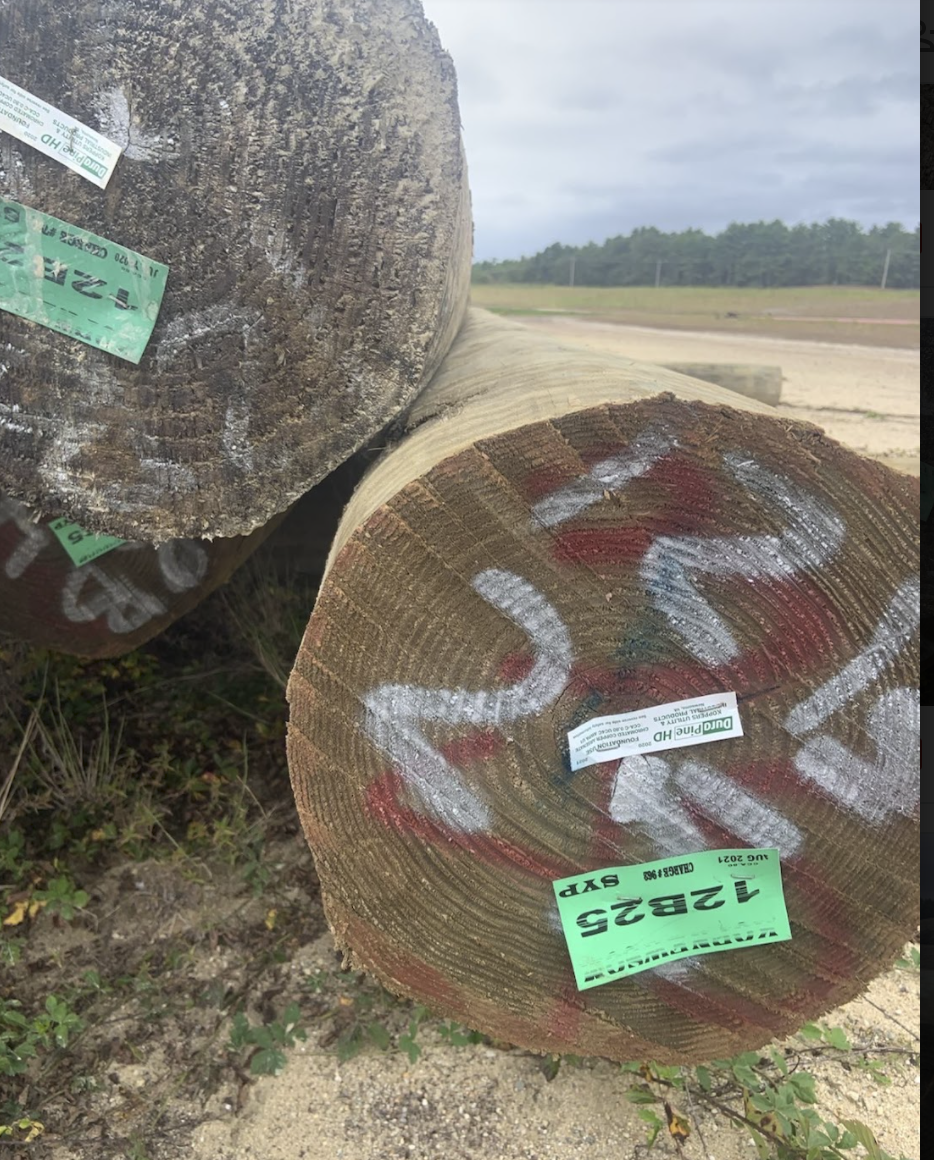
Pine Gate, Tremont Street & Rochester Road, Carver
In June 2019 the Carver Conservation Commission issued the Order of Conditions permit based on plans showing steel poles.
Two years later, on June 15, 2021, Conservation Agent Brooke Monroe did a “pre-construction” site visit with PineGate. According to PineGate, some poles treated with Chromated Copper Arsenate (CCA) had been installed at this point. The CCA treatment on the poles is obvious — did the Conservation Agent ignore this?
On September 5, 2021, Conservation Commission Chair Savery Moore and member Alan Germain did a site visit with PineGate. At this point, the public was observing and reporting CCA on the poles. Did Moore and Germain not see the green coloring on the poles? Did these conservation commission members responsible for protecting our water not notice the green and pink CCA tags on the poles?
On September 10, 2021, Beals+Thomas sends the Conservation Commission a memo saying PineGate is using timber poles. Beals+Thomas refers to the September 5, 2021 site visit with Moore and Germain.
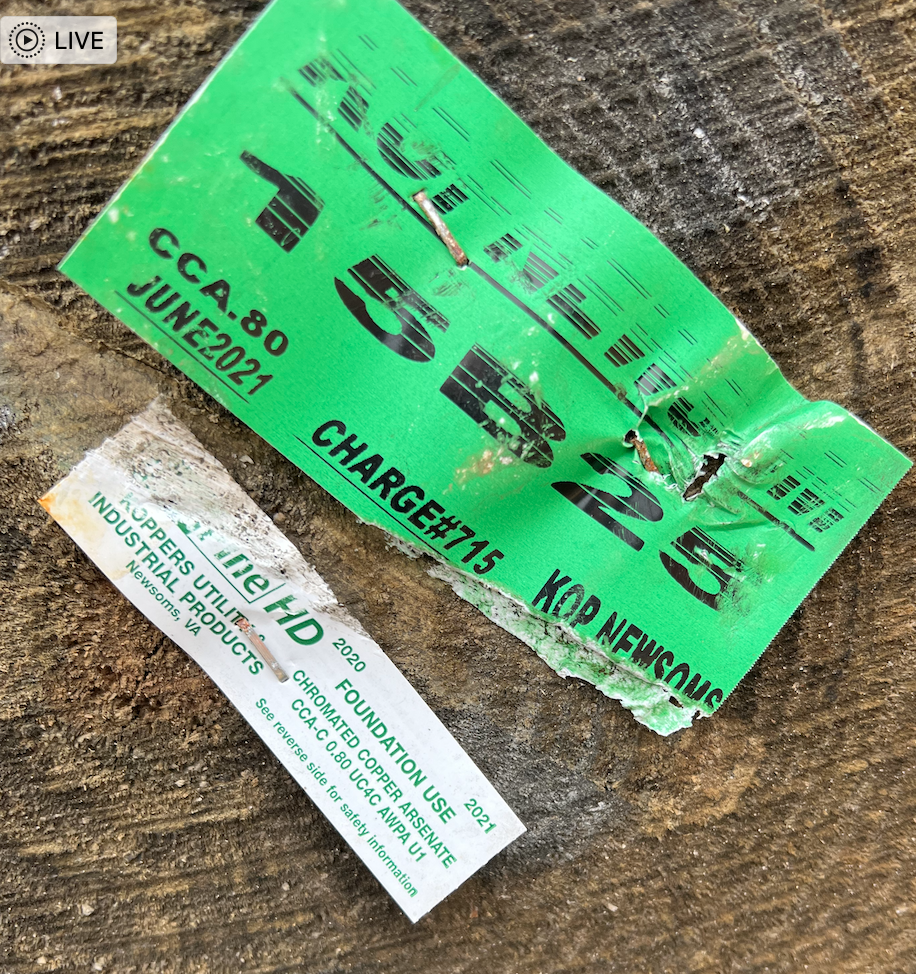
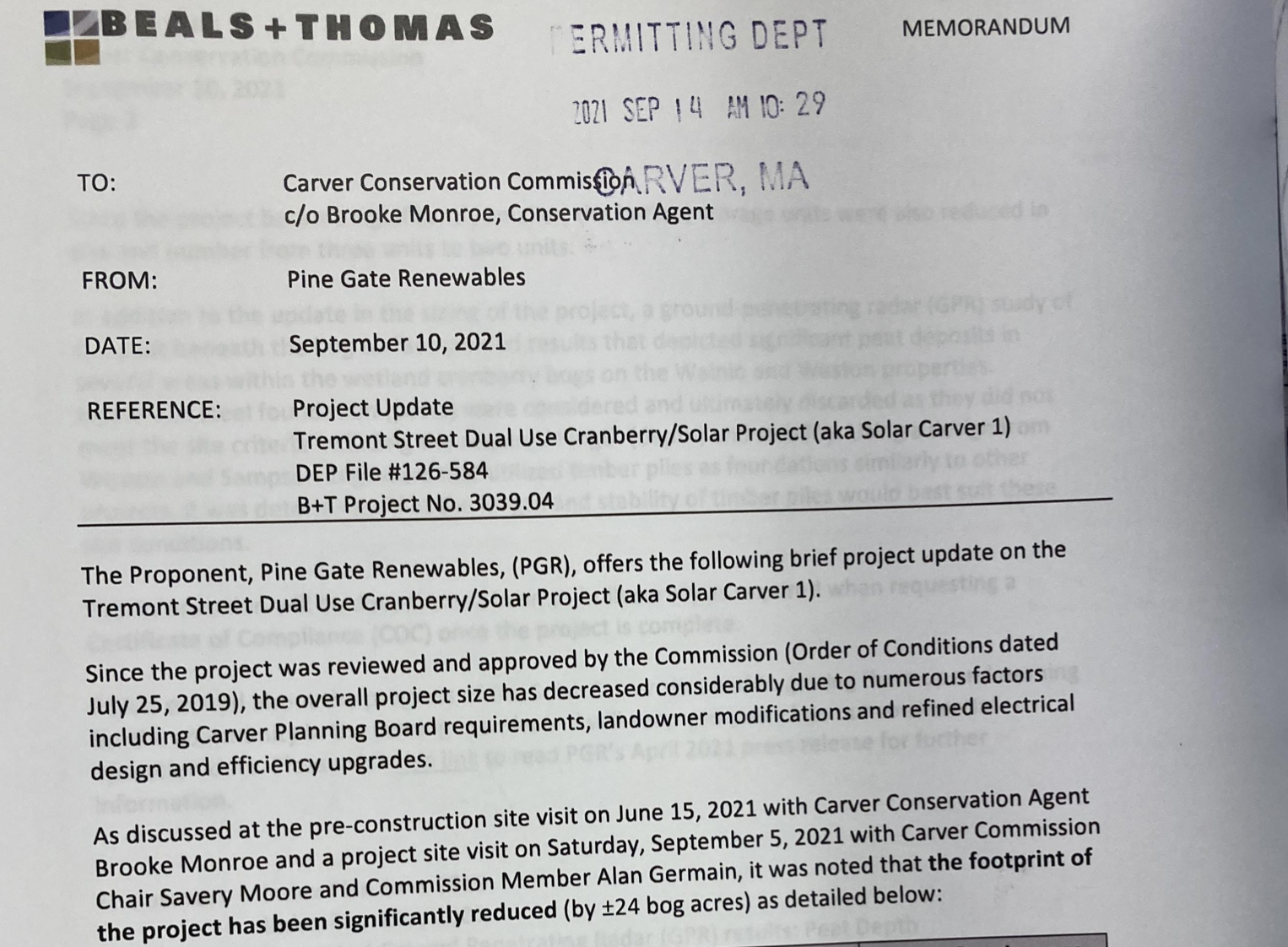
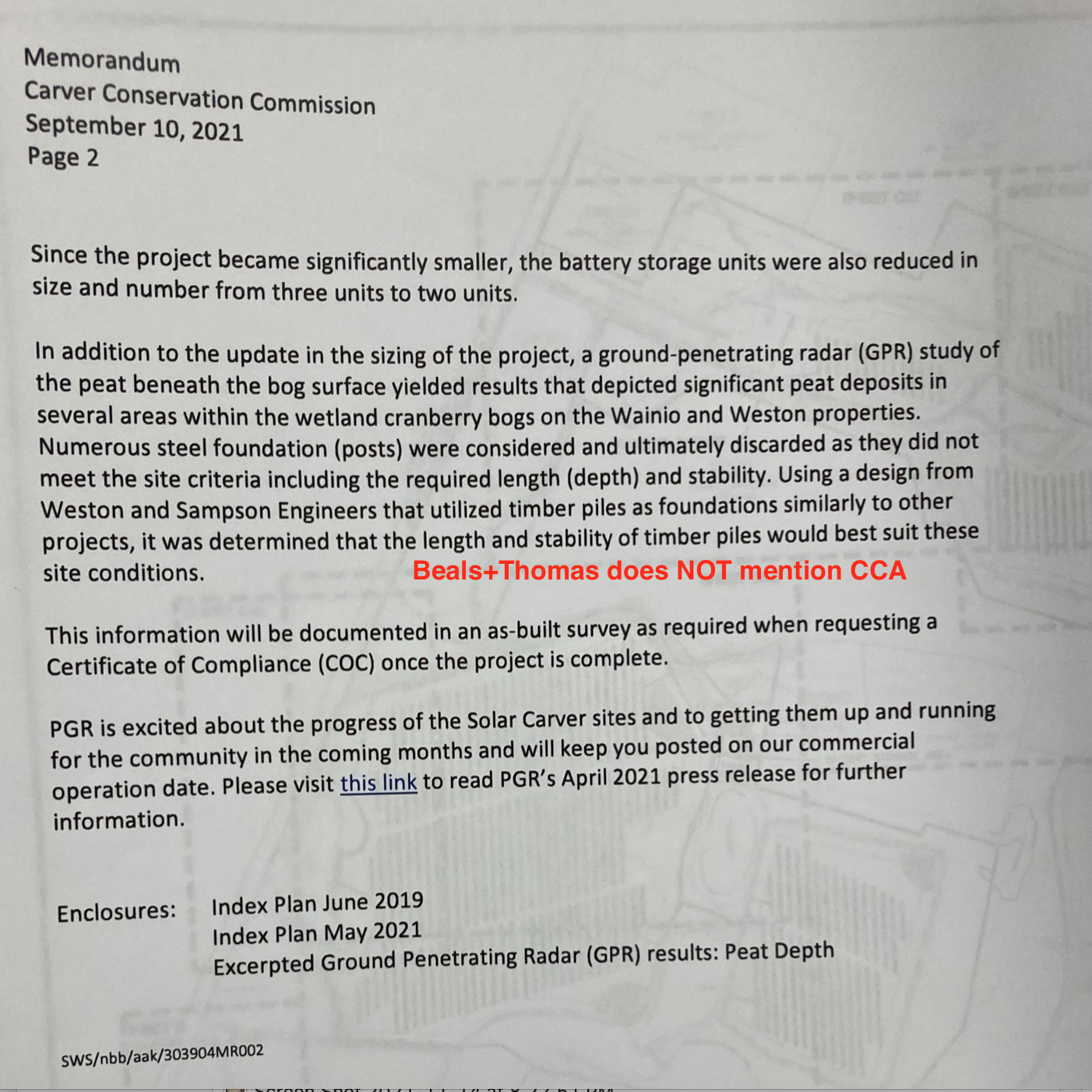
The Conservation Commission put the poles issue on its Agenda for September 15, 2021, listing the agenda item as “Solar project DEP 126-584.” This is the state wetlands permit number. The agenda did not adequately inform the public that the Commission was talking about the CCA poles at Rochester Road and Tremont Street.
Worse yet, the minutes of the Conservation Commission meeting on September 15, 2021 show that they allowed the poles to go ahead without even a modification to the permit. The minutes say, “no vote is required, this discussion is informational.” They say Beals+Thomas Sarah Stearns and cranberry consultant Iain Ward were on the site visit. They quote Conservation Commission member Alan Germain as saying ” when you walk the project you see that the poles are aligned “perfectly” and it may look a little “funky” from the street but they have done a good job maintaining the bogs while working the project.”
How is it possible that the Conservation Commission visited the toxic pole site, “discussed it” and decided that everything was OK? No one saw the CCA arsenic tags or green color of the poles?
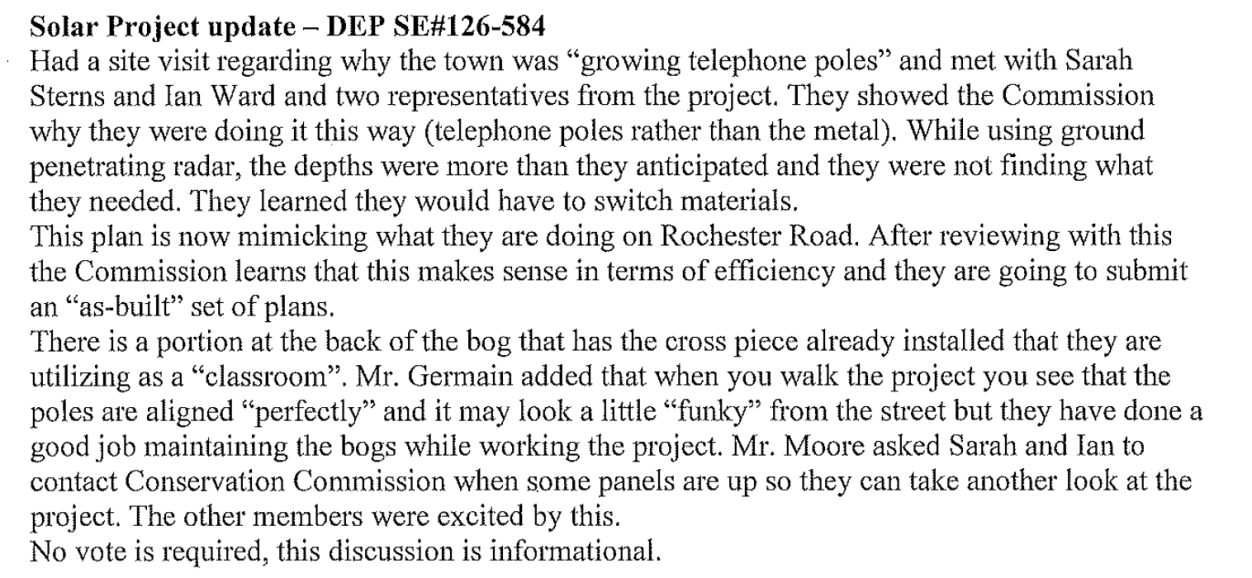
Conservation Commission Minutes Sept 15, 2021Download
On September 28, 2021, Conservation Agent Monroe writes an email saying “when the Commission became aware of the change [to timber poles] they did a site visit with the developer and their Consultant and they were ok with the use of the new poles.” This refers to the Sept. 5, 2021 site visit by Moore and Germain.
Monroe writes she is asking PineGate for more information about the chemicals used to treat the poles. Residents continue to ask questions.
October 6, 2021 the Conservation Commission meets and hears from residents about the poles. The 0 Pond Street solar project was on the agenda but was taken off at the last minute. Why is the Conservation Commission refusing to publicly discuss the AD Makepeace-REDP solar project with toxic poles?
October 10, 2021: As the public exposes the CCA in the poles, Carver Conservation Commission has no choice but to act, issues stop work order.
Carver Enforcement Order against Pinegate Renewables Download
Nov. 18, 2021: Update
Months of public pressure, research, advocacy and exposing the facts — as a result, PineGate will pull the 3,500 arsenic poles from our groundwater at some point. In what appeared to be a pre-determined decision the Carver Conservation Commission accepted a vague plan by Pine Gate Renewables to remove the arsenic poles in the cranberry bogs and replace them with pre-cast concrete.
Why no new Wetlands Bylaw and Wetlands Protection Act application and public hearing? What is the cost of this fix? Will a new building permit be required? Where is PineGate’s testing data? They said it would be presented at the October 2021 Conservation Commission meeting. What do the results say? The public has the right to know.
Who is the Conservation Commission working for? PineGate Renewables or the people of Carver? The Conservation Commission and Planning Board must require a full permit modification for the existing permits for PineGate and AD Makepeace arsenic pole projects.
Why isn’t PineGate being penalized for violating the Order of Conditions? The Carver wetlands bylaw Section 9.2.4.1 allows the Conservation Commission to impose a penalty of $50.00 per day per violation. Each pole is a violation and the poles have been in for months. If there are 3,500 poles that is $175,00.00 per day. That money could be used for continued testing and wetlands restoration.
Why is the Conservation Commission letting AD Makepeace and REDP solar off the hook for arsenic poles at the 0 Pond Street site? Where is the enforcement order for them?
Carver Conservation Commission Records:
0 Pond Street: Solar Canopy & Dual Use Solar: AD Makepeace – REDP Arsenic Poles
A few highlights: The Public Notice does not mention the use of timber poles or the use of CCA poles.
Pdf page 43-Makepeace’s consultant, Beals+Thomas application describes strip mining for the dual us part of this project, disguising it as “agricultural” for “bog sand”. The application says “several thousand yards of suitable bog sand will be removed” to make way for ‘dual use’ ground mounted solar project Massachusetts DOER has approved this project – meaning that DOER is sanctioning deforestation and strip mining for “dual use” solar. The 2019 application also refers to REDP’s Gate Street dual use project. It claims that there is a farm plan for that — as of Sept. 2021 still no farm plan for the REDP Gate Street “dual use” solar project according to Hank Ouimet of REDP, on vido at a Rochester Conservation Commission meeting.
0 Pond Street, Carver: Stormwater Report required by federal Clean Water Act:
Press Release: Pull the Poles
Nov. 17, 2021
Are local cranberries safe to eat? Has arsenic poisoned our drinking water wells?
Local residents are demanding answers from the Baker Administration and local officials. The Pull the Poles Campaign hosted a tour of two large solar installations where about 3,500 arsenic-treated wood poles have been driven into peat bogs and groundwater to mount solar panels.
Concerned residents are demanding answers from state and local officials. Cranberry bog poles are treated with Copper Chromated Arsenic (CCA), a toxic pesticide.
Nov. 10, 2021: Take action!
We need your help in asking local and state officials to protect our waters, food sources, and ecosystems from the chemicals in the toxic solar poles!
Click here to send an email in a few minutes or write one in your own words
October 21, 2021: Carver Conservation Commission stop work order
On Oct. 8, 2021 the Carver Conservation Commission issued a stop work order PineGate Renewables for the two arsenic pole sites on cranberry bogs at Rochester Road and Tremont Street. Despite the order, PineGate continued working on Sunday, Oct. 10, 2021. Thousands of arsenic poles have been installed in cranberry bogs which are wetlands of soil and peat. The groundwater is close to the surface. The stop work order continues until at least Nov. 17, 2021 when the Conservation Commission meets at Carver High School Auditorium at 7 p.m.
At its Oct. 21, 2021 meeting, the Carver Conservation Commission heard from local residents about concerns with the CCA treated wood poles. CCA is chromated copper arsenic, a pesticide formulation used to prevent wood from rotting. It is not approved for use in water supplies or on food crops like cranberries that are 99% water.
DEMAND to the Town of Carver:
- PineGate Renewables must file amendments to the permits issued by the Conservation Commission and Planning Board. There must be a public hearing on these permit amendments under the Town Zoning Law, Wetlands Bylaw and state Wetlands Protection Act.
- AD Makepeace & REDP must fully disclose how many CCA treated poles are being installed and what the toxicity is of the CCA.
Additional demands are in this October 20, 2021 letter to Town officials and boards demanding immediate removal of all poles from the three known sites and an investigation of other possible sites.
The solar panel poles are treated with Copper Chromated Arsenic (CCA) to prevent them from rotting in the peat and wetland cranberry bogs. Science shows the arsenic leaches out into surrounding soil and water. Has the arsenic already started leaching? How long before the Plymouth Carver Sole Source Aquifer is poisoned with arsenic? Carver gets 99% of its water from this groundwater source.
Private wells are located only feet from these sites. How long before these private wells become poisoned with arsenic?
We demand answers from a professional team of researchers, hydrologists, toxicologists and soil experts. The state must step in. Local officials have tried to sweep this and the destructive earth removal associated with these sites under the rug for too long.
As of Oct. 6, 2021, according to the Conservation Commission (video starting at 1:08) about 4,000 toxic poles are stacked up to be installed and about 1,500 are in place at two Pine Gate Renewable sites. There are 3 confirmed sites PineGate Renewable sites on Tremont Street and Rochester Road with cost of $53 million and AD Makepeace bog site 0 Pond Street with cost of $2 million.
Documents and info on each site is below.
A fourth site, Rocky Maple bogs, has been approved by Carver and a fifth site, Federal Furnace bogs, a 95 acre site, is proposed.
Our Sole Source Aquifer, soils, wildlife and waterways are being intentionally poisoned by the toxic chemicals that are or will leach from the poles. Consultants like Beals+Thomas, representing AD Makepeace, PineGate Renewables and others did not fully disclose the plans to use these toxic poles so that the public could be informed.
What is CCA?
CCA was banned by EPA in 2004, then use was allowed with labeling and certain conditions following a challenge by the industry. EPA describes CCA way:
Chromated arsenicals, which include chromated copper arsenate (CCA), are a group of pesticides containing chromium, copper, and/or arsenic that protect wood against termites, fungi and other pests that can degrade or threaten the integrity of wood products. Chromated arsenicals-treated wood is used to produce commercial wood poles, posts, shakes, shingles, permanent foundation support beams, pilings, and other wood products permitted by approved labeling
Chromated arsenicals pose cancer and non-cancer health risks of concern to workers in wood treatment facilities. EPA did not find health risks of concern for the general public.
Chromated arsenicals pose risks to aquatic invertebrates and plants.
CCA and other wood preservative chemicals are undergoing a regulatory review by EPA due to potential health risk to humans. Is this safe? Who knows? No one seems to have an answer–not the solar developers, the towns who approved this or the state who provides the ratepayer and taxpayer subsidies.
What is the impact of adding more toxic chemicals to cranberry bogs? For 100 years, the cranberry industry has been dumping pesticides containing chromated arsenicals on the bogs. It also uses large amounts of fertilizers. What is the impact of adding MORE of this toxic chemical to our wetlands on top of our sole source drinking water aquifer? Where are our state regulators such as the Department of Environmental Protection and Department of Energy Resources? Did they give the OK for these “dual use” solar projects that are getting ratepayer energy subsidies as a “dual use” under the SMART solar program?
We’ve asked DOER to assure us that the chemically treated poles in the wetlands won’t leach chemicals into our groundwater. No answer. Cranberries are 90% water. Are chemicals leaching into the berries? Maybe Ocean Spray and its partner Pepsi want to find out.
On Sept. 7, 2021, Hank Ouimet, principal of REDP told the Rochester Conservation Commission that the company planned to use wooden poles treated with Chromated Copper Arsenate (CCA) on its “dual use” project on Neck Road in the Long Pond Bogs on Snapituit Pond. REDP produced a “memo” from its paid consultant in response to the public’s questions about the health and environmental impacts of putting CCA treated poles in an acidic environment like a cranberry bog wetland. This report raises more questions than answers and is not a professional, peer reviewed objective answer. It is linked below.
In May 2021 the public interest group Beyond Pesticides recommended to EPA that use of CCA be banned due to lack of credible scientific information on its safety and “the serious human health and ecological risks” identified by EPA itself. Maybe the cranberry industry should do some research.
Fake Crops for Dual Use Solar
These “dual use” projects are supposed to have crops growing under them. The cranberry industry is hopping on the subsidy bandwagon with solar developers such as NextSun Energy and Renewable Energy Development Partners (REDP) installing these projects every where. The leading spokesman for the cranberry industry essentially says this is an experiment. He says we won’t know for 5-6 years whether crops will grow under the panels.
“There is a lot of thought going into how to do these things right,” said Iain Ward, a veteran cranberry farmer and solar consultant who will be operating the parcels in Carver for Pine Gate. “In five to six years, we’re going to have new best practices specifically tailored to growing crops under dual-use arrays.”
At the REPD solar site in Carver, principal Hank Ouimet admitted publicly on Sept. 7, 2021 that even though the “dual use” project is installed, there is no farm plan as required by DOER and no crops growing.
Why are we gambling with our farmland at a time when arable land is at a premium and locally grown food is a trend? These projects are in direct conflict with the state’s professed goals of sustainable agriculture and “grow local” Massachusetts — and don’t make sense. These industrial power utilities on agricultural land locks us in to 20-30 years — the life of one of these solar projects.

Keep me updated. Thanks